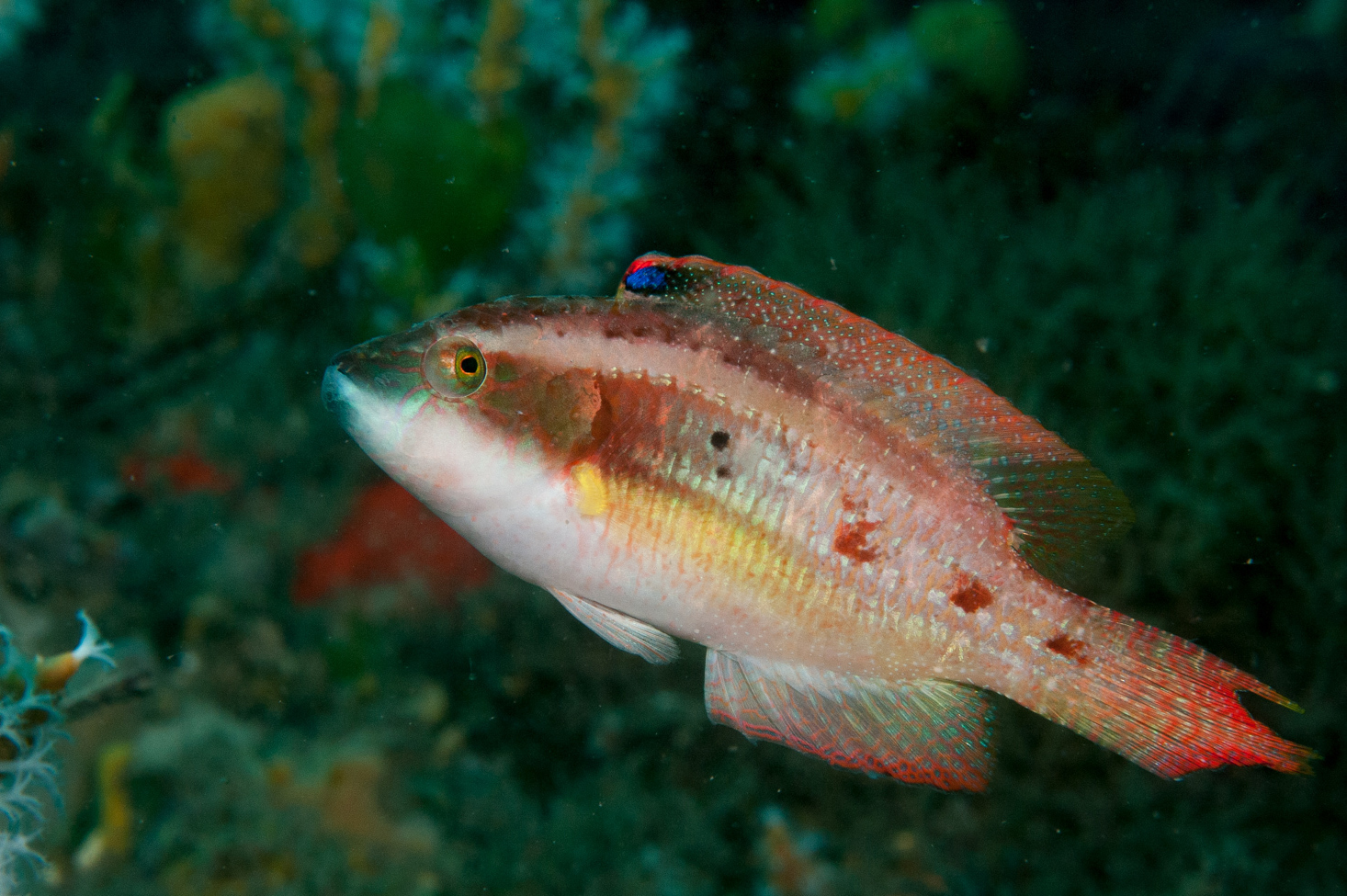- Classification
- ACTINOPTERYGII
- PERCIFORMES
- LABRIDAE
- Oxycheilinus
- bimaculatus
Little Maori Wrasse, Oxycheilinus bimaculatus (Valenciennes 1840)
Other Names: Little Maori, Little Maori-Wrasse, Twospot Maori Wrasse, Two-spot Maori Wrasse

A male Twospot Maori Wrasse, Oxycheilinus bimaculatus, at Fly Point, Port Stephens, New South Wales, November 2016. Source: Erik Schlogl / iNaturalist.org. License: CC BY Attribution-NonCommercial
Summary:
Males are reddish to greenish-brown with irregular brownish bars along the side, a large reddish patch above the pectoral fin, and a blue spot at the front of the dorsal fin. Females are brown to reddish-brown with pale and dark flecks and blotches, and indistinct fine white bars along the side. Juveniles have a broad, dark mid-lateral stripe that breaks into dark blotches in adults, the largest above the pectoral-fin tip. Males develop elongate filaments on the tail with the uppermost rays prolonged into filaments.
Video of a Little Maori Wrasse
Video of a Little Maori Wrasse
Cite this page as:
Bray, D.J. 2020, Oxycheilinus bimaculatus in Fishes of Australia, accessed 01 Jul 2025, https://fishesofaustralia.net.au/home/species/261
Little Maori Wrasse, Oxycheilinus bimaculatus (Valenciennes 1840)
More Info
|
Distribution |
Shark Bay to Ningaloo Reef and the Montebello Islands, offshore reefs of north Western Australia, Ashmore Reef in the Timor Sea, and the far northern Great Barrier Reef, Queensland, south to at least Jervis Bay, New South Wales; also Cocos (Keeling) Islands in the eastern Indian Ocean, and Lord Howe Island in the Tasman Sea. Elsewhere the species is widespread in the Indo-west-central Pacific, from east Africa and the Red Sea to the Hawaiian Islands and the Marquesas, north to Japan and south to Australia. Inhabits clear lagoon and outer reef slopes, amongst rubble and sandy areas, or amongst algae; also occurs in estuaries and harbours. Although secretive, Little Maori Wrasse are relatively common in parts of their range. |
|
Features |
Dorsal fin IX, 10-11; Anal fin III, 8; Pectoral fin 12-13; Lateral-line scales 14-16 + 5-7; Gill rakers 11-14.. Mouth terminal or lower jaw slightly projecting. Caudal fin of terminal males rhomboid, with central rays longest, and dorsal-most caudal-fin ray elongated into a short filament. |
|
Colour |
Body variable in colour from brown to reddish, yellow or green mixed with various shades and spots. Juveniles have a broad, dark lateral stripe which breaks into dark blotches in adults, the largest above distal pectoral fins. A small dark spot behind eye. |
|
Biology |
Protogynous hermaphrodites - changing sex from female to male during their life cycle. |
|
Etymology |
The specific name bimaculatus is from bi-, (= two) and maculatus (= spotted),in reference to the two “rather strong” (translation) spots, one behind eye (pale blue, surrounded by green), the other on the side, on sixth row of scales (very black, without a border) (Scharpf & Lazara, 2020) |
|
Species Citation |
Cheilinus bimaculatus Valenciennes in Cuvier & Valenciennes 1840, Hist. Nat. Poiss. 14: 96. Type locality: Hawaiian Islands. |
|
Author |
Bray, D.J. 2020 |
|
Resources |
Little Maori Wrasse, Oxycheilinus bimaculatus (Valenciennes 1840)
References
Allen, G.R. 1997. Marine Fishes of Tropical Australia and South-east Asia. Western Australian Museum. 292 pp.
Allen, G.R. & Erdmann, M.V. 2012. Reef fishes of the East Indies. Perth : Tropical Reef Research 3 vols, 1260 pp.
Allen, G.R. & Smith-Vaniz, W.F. 1994. Fishes of Cocos (Keeling) Islands. Atoll Research Bulletin 412: 1-21.
Francis, M.P. 1993. Checklist of the coastal fishes of Lord Howe, Norfolk, and Kermadec Islands, Southwest Pacific Ocean. Pacific Science 47(2): 136-170.
Gloerfelt-Tarp, T. & Kailola, P.J. 1984. Trawled Fishes of Southern Indonesia and Northwest Australia. Jakarta : Dir. Gen. Fish. (Indonesia), German Tech. Coop., Aust. Dev. Ass. Bur. 406 pp.
Johnson, J.W. 1999. Annotated checklist of the fishes of Moreton Bay, Queensland, Australia. Memoirs of the Queensland Museum 43(2): 709-762.
Johnson, J.W. 2010. Fishes of the Moreton Bay Marine Park and adjacent continental shelf waters, Queensland, Australia. pp. 299-353 in Davie, P.J.F. & Phillips, J.A. Proceedings of the Thirteenth International Marine Biological Workshop, The Marine Fauna and Flora of Moreton Bay. Memoirs of the Queensland Museum 54(3)
Kuiter, R.H. 1992. Tropical Reef-Fishes of the Western Pacific, Indonesia and Adjacent Waters. Jakarta : PT Gramedia Pustaka Utama 314 pp. pls.
Kuiter, R.H. 1993. Coastal Fishes of South-eastern Australia. Bathurst : Crawford House Press 437 pp.
Kuiter, R.H. 2002. Fairy & Rainbow Wrasses and their Relatives. Chorleywood, U.K. : TMC Publishing 207 pp.
Myers, R.F. 1999. Micronesian Reef Fishes. Coral Graphics. 330 pp.
Randall, J.E. 2005. Reef and shore fishes of the South Pacific. New Caledonia to Tahiti and the Pitcairn Islands. Honolulu : University of Hawaii Press 707 pp.
Randall, J.E., Allen, G.R. & Steene, R. 1990. Fishes of the Great Barrier Reef and Coral Sea. Bathurst : Crawford House Press 507 pp.
Randall, J.E., Allen, G.R. & R.C. Steene. 1997. Fishes of the Great Barrier Reef and Coral Sea. Crawford House Press. 557 pp.
Scharpf, C. & Lazara, K.J. 2020. Order LABRIFORMES: Family LABRIDAE (i-x) in The Etyfish Project, Fish Name Etymology Database, accessed 7 June 2020, http://www.etyfish.org/labriformes2/
To, A., Liu, M., Rocha, L. & Craig, M. 2010. Oxycheilinus bimaculatus. The IUCN Red List of Threatened Species 2010: e.T187523A8557703. http://dx.doi.org/10.2305/IUCN.UK.2010-4.RLTS.T187523A8557703.en. Downloaded on 24 September 2016.
Valenciennes, A. in Cuvier, G.L. & Valenciennes, A. 1840. Histoire Naturelle des Poissons. Paris : Levrault Vol. 14 464 pp. pls 389-420. See ref at BHL
Westneat, M.W. 1993. Phylogenetic relationships of the tribe Cheilinini (Labridae: Perciformes). Bulletin of Marine Science 52(1): 351-394.
Westneat, M.W. 2001. Labridae. pp. 3381-3467 in Carpenter, K.E. & Niem, T.H. (eds) The Living Marine Resources of the Western Central Pacific. FAO Species Identification Guide for Fisheries Purposes. Rome : FAO Vol. 6 pp. 3381-4218.








